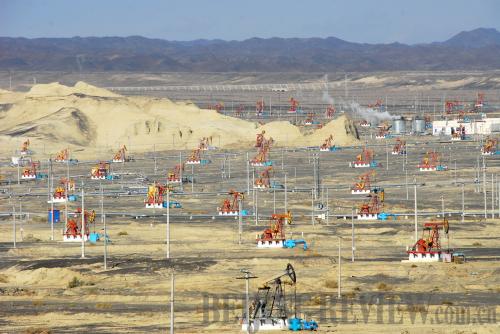|
 |
|
RESOURCE ADVANTAGES: The output of crude oil at Karamay Oilfield in Xinjiang reached 12.21 million tons in 2008. The output has grown for 28 consecutive years (CFP) |
"Besides the partner assistance program, all the ministries and commissions of the Central Government will also offer their support," Tang said, when interviewed by China News Service. Tang said the Ministry of Education would spend 80 billion yuan ($11.71 billion) within five years to improve the educational infrastructure in Xinjiang.
In an article written for Century Weekly, Yu Jun, Executive General Manager of the Research Department of CITIC Securities Co. Ltd., said the Central Government has greatly supported the border areas and areas inhabited by ethnic minorities. Yu thinks addressing the need to enhance Xinjiang's internal economic development impetus is the key point of the conference.
Now that the conference has concluded, many infrastructure projects and projects related to people's livelihood will be launched. Yu anticipates that the Central Government will continue to strengthen the investment in infrastructure projects in Xinjiang—mainly housing development in south Xinjiang and power grids and railways that can ensure energy transmission.
The central work conference on Xinjiang stated more fiscal resources to the public service sector and to the projects with significant public interest were required. Yu thought this was a means for the government to shift away from its former subsidy-oriented supporting pattern.
Construction of these infrastructure projects will not only drive demand of some related industries, but will also promote the development of some industries, such as potash fertilizer and coal, the expansion of which was restricted by the underdeveloped transport facilities.
In another Century Weekly article, Lei Yao, a researcher at the Research Bureau of the People's Bank of China, thought the new policies are not only conducive to the development of Xinjiang, but also of practical significance to the whole country in three aspects.
Revamping the resource tax can first of all enhance the local financial strength of Xinjiang, while a more reasonable mechanism for resource utilization may provide a catalyst to transfer resource advantages into industrial advantages. The resource tax revamp is conducive to efficiently and intensively utilizing Xinjiang's rich resources. It can also be anticipated that the achievements in Xinjiang during the revamp trials will inevitably help to increase the efficiency of resource development, allocation and utilization throughout the whole country.
China is currently formulating general ideas and policies to deepen the Western Development Strategy over the next decade, and by strengthening the opening up process in Xinjiang, the country may find a unique way of continuing such efforts on a course different from the opening up of the eastern region.
To implement the new measures to boost development in the autonomous region, Xinjiang needs to make full use of the principal role of the market in resource allocation and be able to develop through economic and technological cooperation with other provinces, autonomous regions and municipalities. | 